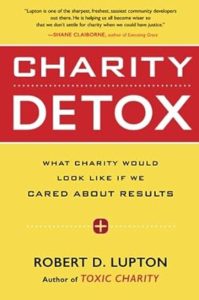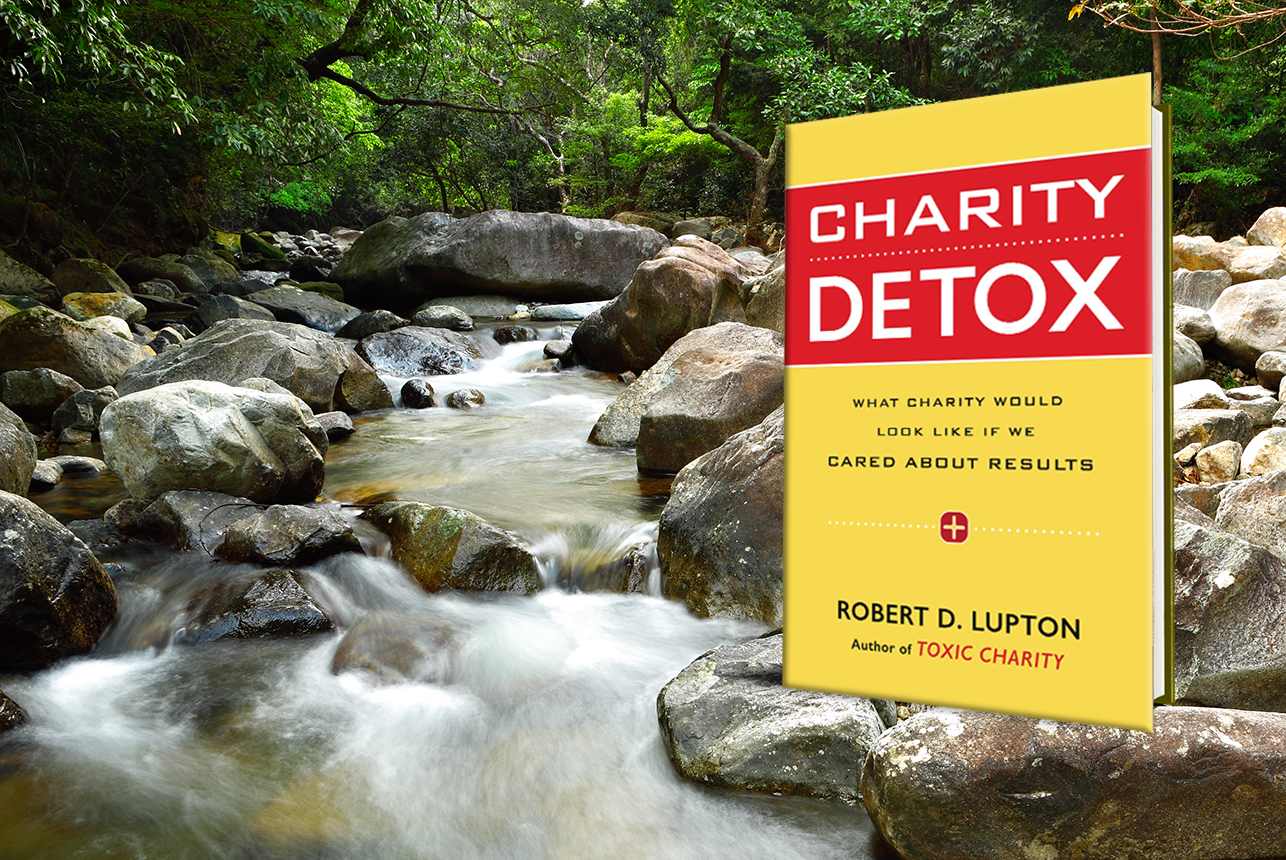Charity Detox by Robert Lupton

Jeff Lofting
Director of Education
Read more from Jeff
Jump to:
The Purpose of the Book | The Perspective | The Key Points | Details We Love | Considerations | Who Should Read This?
Imagine a situation in which you learned that the water that you had been drinking for some time had been revealed to be toxic – what you thought was life-giving was actually bringing harm to those who consumed it. In 2011, Robert Lupton wrote an exposé of sorts, entitled Toxic Charity, that revealed to many that the charity they had practiced for years could likewise be toxic. It was important to realize this, but what does one do to replace toxic practices with those that are life-giving? Robert Lupton’s Charity Detox aims to provide the groundwork and methods for purifying one’s charity.
Lupton writes from the perspective of a 40-year veteran in the trenches of inner city community restoration. Throughout this long tenure of service, he has evaluated a myriad of methods to alleviate poverty. He’s not concerned with the partisan politics that often surround this topic—he cares about results. His tone is direct and action-oriented, and he provides clear, applicable examples of many successful organizations who have paved the way to operating in an effective model of charity that is driven by outcomes, instead of just activities.
“A healthy society is a working society.” Although at first it may not be the most obvious need when you consider the importance of food, education, and sharing the Gospel. Lupton argues that the framework of a healthy society is based on its economic stability. When the ability for those in your community to exercise their talents or participate in a mutual exchange of goods or services is removed, their dignity and desire to thrive is discounted. If you only focus on alleviating a perceived food crisis, the issue will become chronic. If you only focus on education, you will cause a vacuum as the graduates leave the community. “Education is a ticket out,” as Lupton points out, not a ticket to community growth. He argues that combining service, education, and the gospel with economic development is the only way to push the poverty needle. Lupton argues, “Subsidizing inactivity is a bad practice … [T]hey will not thrive if they are induced by charity … to be unproductive. Purposeful work is what establishes one’s place in society” (32).
Missions as a Business Model: The majority of Charity Detox outlines a variety of business methods, such as market demands and return on investment (ROI), which might not be as familiar of concepts to those in the nonprofit sector. He notes that many nonprofit organizations have seen a perceived need and have jumped in too quickly with a service project; it ended up not quite meeting the need, as intended. Lupton argues that if the charity or church had taken the time to assess the specific needs of those they were trying to serve, they would have been able to meet those needs more successfully. “A good businessman knows to listen to the consumer.” Ultimately, success should be measured by ROI, or desired outcomes actually being met. Most businessmen know that, without a good return, they are out of business. And it’s something they constantly have to monitor. Calculating the “return on charitable investments” hasn’t always been a priority. Lupton lists a variety of ways, though, that charities and non-profit organizations can start measuring the effectiveness of their mission model, such as self-reliance, relationship, spiritual results, and computerized systems of accountability.
The 3 R’s of Community Development: Lupton’s book is not just theory. He does an excellent job of providing many concrete steps and methods that he has seen work successfully. In one chapter, he outlines three elements that charities and churches have implemented in their communities that have provided more effective outcomes. (These 3 R’s were originally developed by veteran community developer, John Perkins.)
- Reneighboring: Middle-income or wealthy church members moving into a mixed-economic community to create a healthier community for the poor.
- Reconciliation: Attempting to right wrongs that have occurred in a community and rebuilding trust among those in that community to provide the groundwork for growth.
- Redistribution: Lupton clarifies that this is not the same as “taking from the rich and giving to the poor”—it is providing opportunities for exchange and reminding community members that each neighbor has something to offer.
One of the best features of this book is the numerous examples Lupton uses to validate his hopes for more effective charity. In contrast to typical missions trips, Lupton advocates for a modification in which the visiting group collaborates with locals to brainstorm innovative ways to revitalize their economy while also contributing to their local tourist market. Instead of food pantries and soup kitchens providing handouts, Lupton shares an example of a rescue mission that houses 500 homeless guests each night, where most services are performed by the guests themselves, conducted with accountability and in an orderly fashion. An entire chapter is dedicated to social enterprise, combining business with charity that can lead to better outcomes. His numerous examples paint a hopeful picture that shows that there are alternatives to simply handouts that perpetuate poverty; there are solutions that help individuals overcome cyclical poverty while affirming the dignity and contribution of each individual.
Although Lupton’s stories and personal examples help the reader to see philosophy in action, Lupton’s use of anecdotes might leave the reader looking for more hard evidence of these methods actually moving the poverty needle. Additionally, Lupton’s contention that business methods should be more heavily relied upon in the realm of nonprofits might initially set some nonprofit leaders’ teeth on edge. But keep reading: Lupton advocates for partnership between those who are more business-minded and entrepreneurial in order to develop more effective charitable strategies rather than castigating nonprofits’ typical focus on social services (see chapter two, Partnering with Business).
This book is written for a wide spectrum of individuals. Anyone serving in or supporting missions, charities, or non-profits will find the concepts in this book helpful in determining the best use of their time and money. In addition, this book can inspire business-minded individuals to consider more ethical methods of business and how they could use their God-given skills and knowledge to not just financially support organizations, but share and teach their methods with those same non-profits. Finally, all spiritual leaders responsible for their organizations, churches, or programs will find this book an easy segue into broaching the topic of change within their organization, especially after having read Lupton’s Toxic Charity.
 Charity Detox can be purchased at Amazon. If you purchase the book through this link, True Charity will earn a small amount as an Amazon Associate
Charity Detox can be purchased at Amazon. If you purchase the book through this link, True Charity will earn a small amount as an Amazon Associate

This article is just the tip of the iceberg for the practical resources available through the True Charity Network. Check out all of the ways the network can help you learn, connect, and influence here.
Already a member? Access your resources in the member portal.



